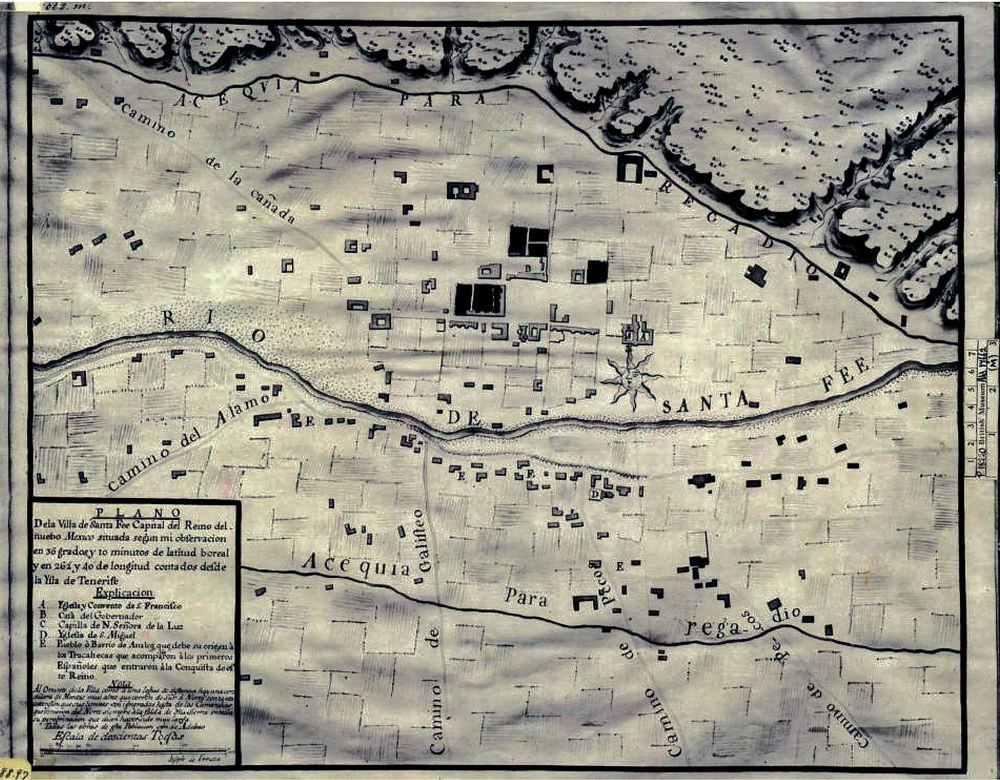Last week I drove to Santa Fe and visited some of the oldest buildings in the United States. One of those building was San Miguel Chapel.
Don Pedro de Peralta established Santa Fe in 1610, when he moved New Mexico’s capital south from San Juan de los Caballeros, near the modern city of Española. The site he chose was on the north side of the Santa Fe River. As was common in that period, Peralta built a rectangular set of buildings that faced inward toward a central plaza. This plan resulted in the Palace of the Governors and the city plaza, both of which remain at the center of Santa Fe. The Palace of the Governors is the oldest public building in the continental United States that was constructed by European settlers and has been in continuous use.
Don Pedro de Peralta established Santa Fe in 1610, when he moved New Mexico’s capital south from San Juan de los Caballeros, near the modern city of Española. The site he chose was on the north side of the Santa Fe River. As was common in that period, Peralta built a rectangular set of buildings that faced inward toward a central plaza. This plan resulted in the Palace of the Governors and the city plaza, both of which remain at the center of Santa Fe. The Palace of the Governors is the oldest public building in the continental United States that was constructed by European settlers and has been in continuous use.
 Spanish/Tlaxcalan Contract
Spanish/Tlaxcalan ContractAcross the river from the Palace, Peralta allowed the Tlaxcalans who accompanied him into New Mexico to found a neighborhood of their own, which also still exists. This neighborhood, or barrio, is called El Barrio de Analco. Analco” is a Nahuatl word which became incorporated into the Castilian of New Spain. It means “on the other side” or “beyond the river.”
The Tlaxcalans lived east of Mexico City, in what is now the state of Tlaxcala. They had never been conquered by the Aztecs. They spoke Nahuatl. In 1521, they allied themselves with Cortes to defeat the Aztecs. Afterwards, those Tlaxcalans who agreed to settle in the north were given the right to live in their own neighborhoods (barrios), free from tributes, taxes, and personal service. To protect the Tlaxcalans, Spaniards were not allowed to buy their property. Unlike other Native Americans, Tlaxcalans who went to the new settlements were permitted to carry arms and ride saddled horses without penalty. According to some sources, as many as 700 Tlaxcalans came north into New Mexico with Don Pedro de Peralta. The Barrio de Analco became the northernmost of the Tlaxcalan barrios.
The Tlaxcalans lived east of Mexico City, in what is now the state of Tlaxcala. They had never been conquered by the Aztecs. They spoke Nahuatl. In 1521, they allied themselves with Cortes to defeat the Aztecs. Afterwards, those Tlaxcalans who agreed to settle in the north were given the right to live in their own neighborhoods (barrios), free from tributes, taxes, and personal service. To protect the Tlaxcalans, Spaniards were not allowed to buy their property. Unlike other Native Americans, Tlaxcalans who went to the new settlements were permitted to carry arms and ride saddled horses without penalty. According to some sources, as many as 700 Tlaxcalans came north into New Mexico with Don Pedro de Peralta. The Barrio de Analco became the northernmost of the Tlaxcalan barrios.
 San Miguel Chapel
San Miguel ChapelAlthough the earliest surviving historical written record dates from 1628, it is likely that the Franciscans who accompanied Peralta began designing and supervising the construction of the San Miguel Chapel in the Barrio de Analco soon after they arrived in 1610. Archaeologists say that its foundations were laid directly over an early Pueblo settlement that existed between 800 and 1300 CE. In addition to serving the Tlaxcalans, the chapel was used by the Spanish middle class, which consisted of laborers, artisans, tradesmen, and farmers. Spanish soldiers also attended mass in the chapel.
 The Retablo, 1798
The Retablo, 1798In 1680, the Indigenous Puebloans revolted in a coordinated attack. On the first day of the revolt, the Puebloans, jealous of the special treatment the Spaniards accorded their Tlaxcalan allies, and angry that Tlaxcalans had Puebloan servants, burned the church of San Miguel and almost wiped out the Analco Barrio. The Tlaxcalans joined the more than 2000 Spanish in their retreat south to El Paso. Twelve years later, in 1692, they returned and began rebuilding the chapel. Although it has undergone significant structural changes, the present building dates from 1710.
In 1859, a decade after the US took New Mexico and Upper California from Mexico in the Mexican American War, Archbishop Lamy purchased the Chapel and adjacent land for the De LaSalle Christian Brothers. The Brothers built a three-story school building next to the Chapel. The school continued to teach students until 1968, when St Michael’s High School was built. The third story burned, but two stories of the old school building, which is the largest all-adobe building in the state, still stands and now houses State Government offices.

Jennifer Bohnhoff taught New Mexico History to 7th graders at two different school. Now retired, she tours places of historical importance within the state as research for historical novels written for middle grade readers through adults. Her next novel, Where Duty Calls, is about the Civil War in New Mexico, and will be published by Kinkajou Press, a division of Artemesia Publishing, in June 2022.







No comments:
Post a Comment